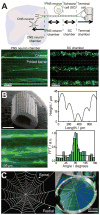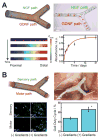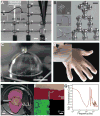3D Printed Bionic Nanodevices
- PMID: 27617026
- PMCID: PMC5016035
- DOI: 10.1016/j.nantod.2016.04.007
3D Printed Bionic Nanodevices
Erratum in
-
Corrigendum to "3D printed bionic nanodevices" [Nano Today 11 (2016) 330-350].Nano Today. 2019 Apr;25:156. doi: 10.1016/j.nantod.2019.03.009. Epub 2019 Apr 10. Nano Today. 2019. PMID: 31186673 Free PMC article.
Abstract
The ability to three-dimensionally interweave biological and functional materials could enable the creation of bionic devices possessing unique and compelling geometries, properties, and functionalities. Indeed, interfacing high performance active devices with biology could impact a variety of fields, including regenerative bioelectronic medicines, smart prosthetics, medical robotics, and human-machine interfaces. Biology, from the molecular scale of DNA and proteins, to the macroscopic scale of tissues and organs, is three-dimensional, often soft and stretchable, and temperature sensitive. This renders most biological platforms incompatible with the fabrication and materials processing methods that have been developed and optimized for functional electronics, which are typically planar, rigid and brittle. A number of strategies have been developed to overcome these dichotomies. One particularly novel approach is the use of extrusion-based multi-material 3D printing, which is an additive manufacturing technology that offers a freeform fabrication strategy. This approach addresses the dichotomies presented above by (1) using 3D printing and imaging for customized, hierarchical, and interwoven device architectures; (2) employing nanotechnology as an enabling route for introducing high performance materials, with the potential for exhibiting properties not found in the bulk; and (3) 3D printing a range of soft and nanoscale materials to enable the integration of a diverse palette of high quality functional nanomaterials with biology. Further, 3D printing is a multi-scale platform, allowing for the incorporation of functional nanoscale inks, the printing of microscale features, and ultimately the creation of macroscale devices. This blending of 3D printing, novel nanomaterial properties, and 'living' platforms may enable next-generation bionic systems. In this review, we highlight this synergistic integration of the unique properties of nanomaterials with the versatility of extrusion-based 3D printing technologies to interweave nanomaterials and fabricate novel bionic devices.
Keywords: 3D printing; 4D printing; active functional devices; bio-nano hybrids; bioelectronics; bionic devices; cyborgs; electronic skins; nanodevices; nanomaterials.
Figures












References
-
- Lavine M, Roberts L, Smith O. Science. 2002;295:995. - PubMed
-
- Craelius W. Science. 2002;295:1018–1021. - PubMed
-
- Clausen J. Nature. 2009;457:1080–1081. - PubMed
-
- Vogel G. Science. 2002;295:1020. - PubMed
-
- Dictionary.com. Unabridged. Random House, Inc;
Grants and funding
LinkOut - more resources
Full Text Sources
Other Literature Sources
